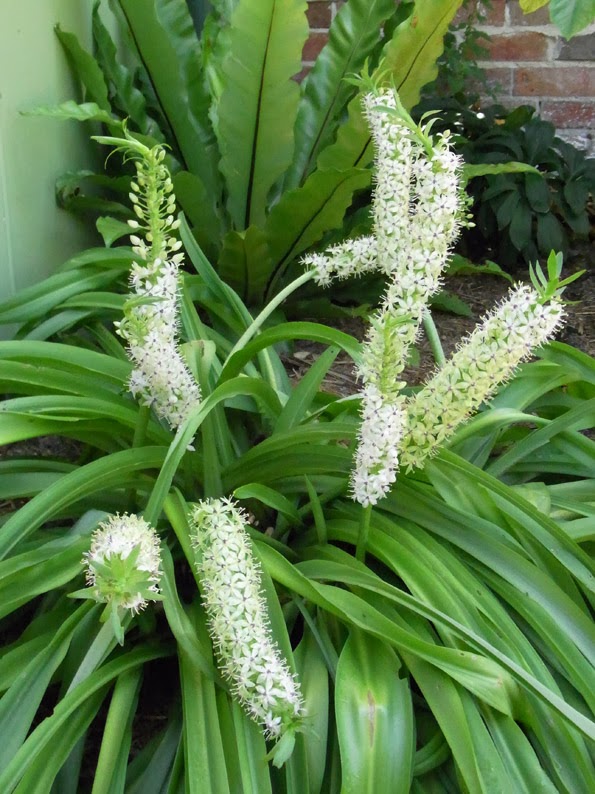Monday, February 24, 2014
Lemons, limes and chicken poo
There's a farmyard scent in the air right now in our garden, so Pammy's gone out shopping for the day. Yep, it's citrus feeding time once again, folks, and the nostril-poking "wake-up!" scent of chicken poo fills the air. It only lasts a few days, but that familiar, twice-a-year smell imprints itself on my memory as powerfully as the colours of seasonal flowers.
Anyway, on with the road test. It seems to me that the so-called 'reduced odour' chicken poo merely stinks to high heaven for a shorter period of time. It doesn't not stink, by any means. It just runs out of stink well before standard Dynamic Lifter does. So in that sense it's 'reduced odour'
I use the souped-up version of Dynamic Lifter on my citrus trees. It's what they describe as 'Organic Based', rather than organic. That is, it contains a lot of chicken poo, plus some added extras designed to really get citrus fruiting.
The reduced odour Dynamic Lifter is labelled as 'organic'. That is, no fancy additives. I used the low-odour stuff in my vegie patch and to help a line of slow-growing gardenias along. The poor gardenias were planted in late spring and haven't enjoyed this hot, dry summer at all. They've grown just a bit, I've watered them a lot, and I'm hoping that the February rains plus the Dynamic Lifter will encourage them to grow a lot more this autumn. We'll see; if it works, then reduced odour Dynamic Lifter has passed its test.
As for the citrus, they'll bounce back from a yucky, over-dry summer. The general rule with feeding them here in temperate Sydney and elsewhere is to feed them twice a year, late summer and late winter. For me, that's February and August. I've used Dynamic Lifter for the last 20 years on my citrus trees and it'll do me.
I love that seasonal smell, Pammy doesn't, but it lasts just a few days.
Posted by
Jamie
at
10:23 AM
Saturday, February 1, 2014
Pineapple lilies
Labels:
bulbs for warm climates,
eucomis,
pineapple lily,
Scadoxus
Here's your word for the day, folks – "etiolated". It's the word used to describe plants which lack sunshine. It's what's wrong with my pineapple lily flowers, but I don't care, because they don't have a bad case of being etiolated at all. They've just got a mild deficiency that shows up in the strange way they flower. If they were people they'd still be still up and about, but they'd tire more easily. In bad cases, etiolated plants are bedridden hospital patients, rapidly yellowing and on death's door.
So, my pineapple lilies don't look so sick to you? Good. I didn't know they even had a problem until I looked at a photo of how healthy, sun-kissed, athletic pineapple lilies should look, and mine were, by comparison, skinny and rangy, even if they were still rather elegant, scented and pretty. I showed a gardening guru friend, Geoffrey, a photo of them a few years ago, and he replied swiftly that "Your pineapple lilies aren't getting enough sunshine, my boy." Instead of thick, dense spikes of fragrant blooms topped with a spiky green topknot that gives the plant the 'pineapple' part of its name, mine are generally scrawny. They're etiolated. They lack sunshine. They could do better. I don't care!
 |
| If the flower spikes were kissed by more sunbeams, they'd be thicker, more dense and more fragrant. But these still have to be one of the prettier basket cases I've come across. |
 |
| There are several colours mixing it on each bloom: white, a blush of green, purple centres and yellow pollen blobs. |
As it's under the lemon tree it thrives on the regular water and food I give the lemon, and the soil drainage is good. Over the years the two bulbs I planted have grown into quite a clump, without any care from me at all. It dies down in winter, and I do cut off the scrappy dead leaves then. The foliage doesn't get more than 40-60cm tall, and the January flower spikes are about 60cm long.
"Why don't you move it to a sunnier spot?" you may ask. They're all taken, I'm afraid. That's the problem with small gardens – you run out of space. Fortunately this is a plant which is not in its ideal spot, which doesn't flower as well as it should, and yet still satisfies and pleases me.
For gardeners in warm climates like Sydney all the traditional spring-flowering bulbs such as tulips and daffodils are at their best in their first season, and many struggle to flower again in the following year. Jonquils do better here. However, the bulbs which are doing best for me are South African bulbs such as our spring-flowering Scadoxus and our summer flowering Eucomis. They're reliable, tough and easy care, and both are slowly forming bigger clumps as the years go by. I'm glad I planted both of them.
Posted by
Jamie
at
12:49 PM
Subscribe to:
Comments (Atom)


